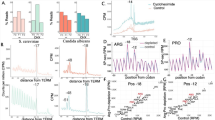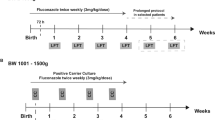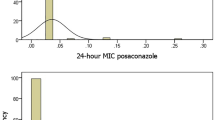Abstract
Background:
Intrauterine Candida albicans infection causes severe fetal inflammatory responses and fetal injury in an ovine model. We hypothesized that intra-amniotic antifungal therapy with fluconazole would decrease the adverse fetal effects of intra-amniotic C. albicans in sheep.
Methods:
Sheep received an intra-amniotic injection of 107 colony-forming units C. albicans. After 2 d, animals were then randomized to: (i) intra-amniotic and fetal intraperitoneal saline with delivery after 24 h (3 d C. albicans group); (ii) intra-amniotic and fetal intraperitoneal injections of fluconazole with delivery after either 24 h (3 d C. albicans plus 1 d fluconazole group) or 72 h (5 d C. albicans plus 3 d fluconazole group). Controls received intra-amniotic injections of saline followed by intra-amniotic and fetal intraperitoneal fluconazole injections.
Results:
Intra-amniotic C. albicans caused severe fetal inflammatory responses characterized by decreases in lymphocytes and platelets, an increase in posterior mediastinal lymph node weight and proinflammatory mRNA responses in the fetal lung, liver, and spleen. Fluconazole treatment temporarily decreased the pulmonary and chorioamnion inflammatory responses.
Conclusion:
The severe fetal inflammatory responses caused by intra-amniotic C. albicans infection were transiently decreased with fluconazole. A timely fetal delivery of antimicrobial agents may prevent fetal injury associated with intrauterine infection.
Similar content being viewed by others
Log in or create a free account to read this content
Gain free access to this article, as well as selected content from this journal and more on nature.com
or
References
Goldenberg RL, Culhane JF, Iams JD, Romero R. Epidemiology and causes of preterm birth. Lancet 2008;371:75–84.
DiGiulio DB. Diversity of microbes in amniotic fluid. Semin Fetal Neonatal Med 2012;17:2–11.
Goldenberg RL, Hauth JC, Andrews WW. Intrauterine infection and preterm delivery. N Engl J Med 2000;342:1500–7.
Jones HE, Harris KA, Azizia M, et al. Differing prevalence and diversity of bacterial species in fetal membranes from very preterm and term labor. PLoS One 2009;4:e8205.
Hay P, Czeizel AE. Asymptomatic trichomonas and candida colonization and pregnancy outcome. Best Pract Res Clin Obstet Gynaecol 2007;21:403–9.
Chaim W, Mazor M, Wiznitzer A. The prevalence and clinical significance of intraamniotic infection with Candida species in women with preterm labor. Arch Gynecol Obstet 1992;251:9–15.
DiGiulio DB, Romero R, Amogan HP, et al. Microbial prevalence, diversity and abundance in amniotic fluid during preterm labor: a molecular and culture-based investigation. PLoS One 2008;3:e3056.
Combs CA, Gravett M, Garite TJ, et al.; ProteoGenix/Obstetrix Collaborative Research Network. Amniotic fluid infection, inflammation, and colonization in preterm labor with intact membranes. Am J Obstet Gynecol 2014;210:125.e1–125.e15.
Marelli G, Mariani A, Frigerio L, Leone E, Ferrari A. Fetal Candida infection associated with an intrauterine contraceptive device. Eur J Obstet Gynecol Reprod Biol 1996;68:209–12.
Benjamin DK Jr, Stoll BJ, Fanaroff AA, et al.; National Institute of Child Health and Human Development Neonatal Research Network. Neonatal candidiasis among extremely low birth weight infants: risk factors, mortality rates, and neurodevelopmental outcomes at 18 to 22 months. Pediatrics 2006;117:84–92.
Darmstadt GL, Dinulos JG, Miller Z. Congenital cutaneous candidiasis: clinical presentation, pathogenesis, and management guidelines. Pediatrics 2000;105:438–44.
Cotch MF, Hillier SL, Gibbs RS, Eschenbach DA. Epidemiology and outcomes associated with moderate to heavy Candida colonization during pregnancy. Vaginal Infections and Prematurity Study Group. Am J Obstet Gynecol 1998;178:374–80.
Czeizel AE, Fladung B, Vargha P. Preterm birth reduction after clotrimazole treatment during pregnancy. Eur J Obstet Gynecol Reprod Biol 2004;116:157–63.
Roberts CL, Rickard K, Kotsiou G, Morris JM. Treatment of asymptomatic vaginal candidiasis in pregnancy to prevent preterm birth: an open-label pilot randomized controlled trial. BMC Pregnancy Childbirth 2011;11:18.
Snyder CC, Wolfe KB, Gisslen T, et al. Modulation of lipopolysaccharide-induced chorioamnionitis by Ureaplasma parvum in sheep. Am J Obstet Gynecol 2013;208:399.e1–8.
Kallapur SG, Nitsos I, Moss TJ, et al. IL-1 mediates pulmonary and systemic inflammatory responses to chorioamnionitis induced by lipopolysaccharide. Am J Respir Crit Care Med 2009;179:955–61.
Moss TJ, Knox CL, Kallapur SG, et al. Experimental amniotic fluid infection in sheep: effects of Ureaplasma parvum serovars 3 and 6 on preterm or term fetal sheep. Am J Obstet Gynecol 2008;198:122.e1–8.
Payne MS, Kemp MW, Kallapur SG, et al. Intrauterine Candida albicans infection elicits severe inflammation in fetal sheep. Pediatr Res 2014;75:716–22.
Bean LM, Jackson JR, Dobak WJ, Beiswenger TR, Thorp JA. Intra-amniotic fluconazole therapy for Candida albicans intra-amniotic infection. Obstet Gynecol 2013;121(2 Pt 2 Suppl 1):452–4.
Bean LM, Jackson JR, Dobak WJ, Beiswenger TR, Thorp JA. Intra-amniotic fluconazole therapy for Candida albicans intra-amniotic infection. Obstet Gynecol 2013;121(2 Pt 2 Suppl 1):452–4.
Brammer KW, Coates PE. Pharmacokinetics of fluconazole in pediatric patients. Eur J Clin Microbiol Infect Dis 1994;13:325–9.
Nørgaard M, Pedersen L, Gislum M, et al. Maternal use of fluconazole and risk of congenital malformations: a Danish population-based cohort study. J Antimicrob Chemother 2008;62:172–6.
Hedenstierna G, Lattuada M. Lymphatics and lymph in acute lung injury. Curr Opin Crit Care 2008;14:31–6.
El-Masry FA, Neal TJ, Subhedar NV. Risk factors for invasive fungal infection in neonates. Acta Paediatr 2002;91:198–202.
Oh KJ, Lee KA, Sohn YK, et al. Intraamniotic infection with genital mycoplasmas exhibits a more intense inflammatory response than intraamniotic infection with other microorganisms in patients with preterm premature rupture of membranes. Am J Obstet Gynecol 2010;203:211.e1–8.
DiGiulio DB, Romero R, Kusanovic JP, et al. Prevalence and diversity of microbes in the amniotic fluid, the fetal inflammatory response, and pregnancy outcome in women with preterm pre-labor rupture of membranes. Am J Reprod Immunol 2010;64:38–57.
Kemp MW, Kannan PS, Saito M, et al. Selective exposure of the fetal lung and skin/amnion (but not gastro-intestinal tract) to LPS elicits acute systemic inflammation in fetal sheep. PLoS One 2013;8:e63355.
Brocklehurst P, Gordon A, Heatley E, Milan SJ. Antibiotics for treating bacterial vaginosis in pregnancy. Cochrane Database Syst Rev 2013;1:CD000262.
Shalev E, Battino S, Romano S, Blondhaim O, Ben-Ami M. Intraamniotic infection with Candida albicans successfully treated with transcervical amnioinfusion of amphotericin. Am J Obstet Gynecol 1994;170(5 Pt 1):1271–2.
Tiboni GM, Marotta F, Carletti E. Fluconazole alters CYP26 gene expression in mouse embryos. Reprod Toxicol 2009;27:199–202.
Jick SS. Pregnancy outcomes after maternal exposure to fluconazole. Pharmacotherapy 1999;19:221–2.
Sorensen HT, Nielsen GL, Olesen C, et al. Risk of malformations and other outcomes in children exposed to fluconazole in utero. Br J Clin Pharmacol 1999;48:234–8.
Jobe AH, Newnham JP, Willet KE, et al. Endotoxin-induced lung maturation in preterm lambs is not mediated by cortisol. Am J Respir Crit Care Med 2000;162:1656–61.
Kallapur SG, Kramer BW, Nitsos I, et al. Pulmonary and systemic inflammatory responses to intra-amniotic IL-1α in fetal sheep. Am J Physiol Lung Cell Mol Physiol 2011;301:L285–95.
Acknowledgements
The authors wish to gratefully acknowledge the support of Siemens Australia for donating the Rapidlab 1200 reagents used in this study.
Author information
Authors and Affiliations
Corresponding author
Rights and permissions
About this article
Cite this article
Maneenil, G., Payne, M., Senthamarai Kannan, P. et al. Fluconazole treatment of intrauterine Candida albicans infection in fetal sheep. Pediatr Res 77, 740–748 (2015). https://doi.org/10.1038/pr.2015.48
Received:
Accepted:
Published:
Issue date:
DOI: https://doi.org/10.1038/pr.2015.48
This article is cited by
-
Neuroinflammation and structural injury of the fetal ovine brain following intra-amniotic Candida albicans exposure
Journal of Neuroinflammation (2016)
-
Ureaplasma parvum genotype, combined vaginal colonisation with Candida albicans, and spontaneous preterm birth in an Australian cohort of pregnant women
BMC Pregnancy and Childbirth (2016)
-
Intra-amniotic Candida albicans infection induces mucosal injury and inflammation in the ovine fetal intestine
Scientific Reports (2016)



